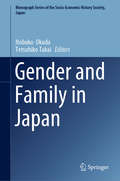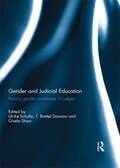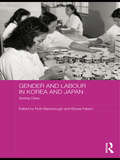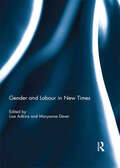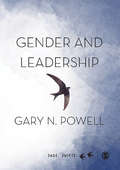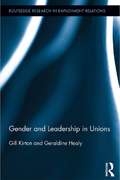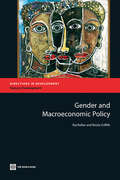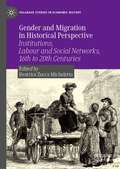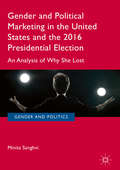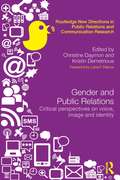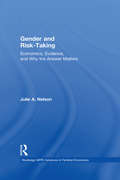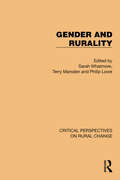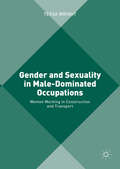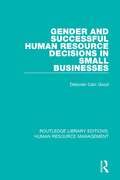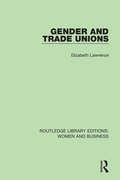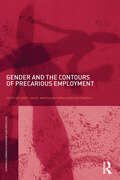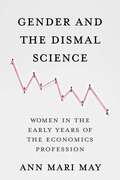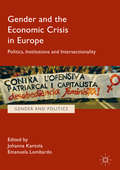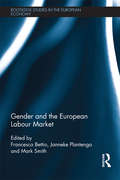- Table View
- List View
Gender and Family in Japan (Monograph Series of the Socio-Economic History Society, Japan)
by Nobuko Okuda Tetsuhiko TakaiThis book is the 6th volume of the Monograph Series of the Socio-Economic History Society, Japan. The book focuses on how economic developments changed the everyday lives of ordinary women in early-modern and modern Japan. Different from precedent gender studies, the spotlight here is on the daily activities and structural positions of women rather than feminist movements or activities of elite women. Using demography, anthropometrics, and labour economics, this book explicates childcare, physical development of girls, and women’s labour migration. The dynamics of ordinary women in prewar Japan may change deep-rooted images of women as oppressed beings. Using quantitative data multi-dimensionally with the latest statistical analysis methods, this book shows how Japanese economic historians can contribute to historians of gender and family who are interested in early-modern and modern Japan. The first part consists of four chapters that discuss women migrant workers in the Tokugawa period, women’s work, and family strategies in the underdeveloped regions of the country, conflicts between child-rearing and women’s work on family farms, and living standards of teenaged girls in early twentieth-century Japan. Those chapters provide a bridge between economic historians and feminist historians and articulate new research fields for both. The second part, comprising four book reviews, illustrates how the gender concept has been adopted in family and gender historiography in Japan.
Gender and Finance: Addressing Inequality in the Financial Services Industry (Contemporary Issues in Finance)
by Ylva BaeckströmThis book examines the world of finance and the role of gender within it. It looks at the financial services industry, arguably the most powerful and remunerative sector that exists, and shows how it was created by men for men. The author explains how historically women were excluded, how minimal progress has been made, and outlines how the sector still needs to change to function effectively in a modern, equal opportunities world. Addressing gender inequality in financial services is of utmost urgency and importance because of the extent to which it affects women in all stages of life. Women’s exclusion in financial services is also mirrored by how men have been excluded from parenting through a similar set of societal expectations, government legislation and corporate policies. The author maintains that to succeed, we need to address both financial services and parenting. To do so we need regulatory support. Because of its power and dominance, the financial services industry has the opportunity to lead this change and to champion gender equal practices. These practices are economically beneficial to all participants, not only female employees and consumers. We all need these benefits as we rebuild our economies following the COVID-19 pandemic. The book makes an important contribution to the critical and increasing awareness of gender concerns. It presents insights drawn from original research and data about gender biases. The book is an essential secondary text for a range of university courses, including economics, finance and accounting, business studies and gender related courses, as well as MBAs and Executive Education programmes that focus on gender in business. It is also a must read for policy makers, managers in financial services institutions and any other businesses that seek to attract the growing market of female consumers, employees and business leaders.
Gender and Free Speech at Google
by Nien-He Hsieh Sarah Mehta Martha J. CrawfordIn August 2017, Google fired James Damore, a 28-year-old software engineer who had been employed by the company since 2013. The move came after Damore penned an internal company memo titled "Google's Ideological Echo Chamber," which posited that innate biological differences between men and women-as opposed to hiring biases, gender discrimination, or a hostile workforce-were at least partially responsible for the low numbers of women in tech. At the time, 20% of Google's tech workforce, and 31% of its overall staff, was female. Damore also admonished Google for silencing opinions that challenged what he viewed as the company's politically liberal belief system. Reactions to both the memo's content and Google's decision to fire Damore were swift and varied. Some praised the company for signaling intolerance of any marginalization of women. Others criticized Google for terminating an employee for a seemingly innocuous act of expression. Danielle Brown, Google's new vice president and chief diversity and inclusion officer, hired just a few weeks before the memo was leaked to the public, must now advise Google's top leadership team on dealing with the fallout.
Gender and Free Speech at Google (A)
by Nien-He Hsieh Sarah Mehta Martha J. CrawfordIn August 2017, Google fired James Damore, a 28-year-old software engineer who had been employed by the company since 2013. The move came after Damore penned an internal company memo titled "Google's Ideological Echo Chamber," which posited that innate biological differences between men and women-as opposed to hiring biases, gender discrimination, or a hostile workforce-were at least partially responsible for the low numbers of women in tech. At the time, 20% of Google's tech workforce, and 31% of its overall staff, was female. Damore also admonished Google for silencing opinions that challenged what he viewed as the company's politically liberal belief system. Reactions to both the memo's content and Google's decision to fire Damore were swift and varied. Some praised the company for signaling intolerance of any marginalization of women. Others criticized Google for terminating an employee for a seemingly innocuous act of expression. Danielle Brown, Google's new vice president and chief diversity and inclusion officer, hired just a few weeks before the memo was leaked to the public, must now advise Google's top leadership team on dealing with the fallout. <p><p> The main learning objectives of this case are to help students: Survey explanations that have been given for the lower number of women in tech Evaluate strategies to increase representation of women and racial and ethnic minorities in tech Review legal protections for free speech in the workplace as well as arguments for free speech in general Appreciate the challenges of managing freedom of expression while trying to promote specific values and an organizational culture that may run counter to some people's views Develop a framework for how to draw lines regarding acceptable and unacceptable speech in the workplace
Gender and Free Speech at Google (B)
by Nien-He Hsieh Sarah MehtaThis case should accompany the (A) and (C) cases, "Gender and Free Speech at Google" (318085) and (319097).
Gender and Free Speech at Google (C)
by Nien-He Hsieh Sarah MehtaThis case reveals Google's response to a list of employee demands aiming to combat sexual misconduct in the workplace. This case should accompany the (A) and (B) cases, "Gender and Free Speech at Google" (318085) and (319085).
Gender and Judicial Education: Raising Gender Awareness of Judges
by Ulrike Schultz, T. Brettel Dawson and Gisela ShawJudicial Education has greatly expanded in common law countries in the past 25 years. More recently it has become a core component in judicial reform programs in developing countries with gender attentiveness as an element required by donor agencies. In civil law jurisdictions judges´ schools have long played a role in the formation of the career judiciary with a focus on entry to the judicial profession, in some countries judges get an intensive in-service education at judicial academies. Gender questions, however, tend to be neglected in the curricula.These judicial education activities have generated a significant body of material and experience which it is timely to review and disseminate. Questions such as the following require answers. What is the current state of affairs? How is judicial education implemented in developed and developing countries all around the world? Who are the educators? Who is being educated? How is judicial education on gender regarded by judges? How effective are these programs?The chapters in this book deal with these questions. They provide a multiplicity of perspectives. Six countries are represented, of these four are civil law countries (Germany, Argentina, Japan, Bosnia and Herzegovina) and two are common law countries (Canada; Uganda). This book was previously published as a special issue of International Journal of the Legal Profession.
Gender and Labour in Korea and Japan: Sexing Class (ASAA Women in Asia Series)
by Elyssa Faison Ruth BarracloughBringing together for the first time sexual and industrial labour as the means to understand gender, work and class in modern Japan and Korea, this book shows that a key feature of the industrialisation of these countries was the associated development of a modern sex labour industry. Tying industrial and sexual labour together, the book opens up a range of key questions: In what economy do we place the labour of the former "comfort women"? Why have sex workers not been part of the labour movements of Korea and Japan? Why is it difficult to be "working-class" and "feminine"? What sort of labour hierarchies operate in hostess clubs? How do financial crises translate into gender crises? This book explores how sexuality is inscribed in working-class identities and traces the ways in which sexual and labour relations have shaped the cultures of contemporary Japan and Korea. It addresses important historical episodes such as the Japanese colonial industrialisation of Korea, wartime labour mobilisation, women engaged in forced sex work for the Japanese army throughout the Asian continent, and issues of ethnicity and sex in the contemporary workplace. The case studies provide specific examples of the way gender and work have operated across a variety of contexts, including Korean shipyard unions, Japanese hostess clubs, and the autobiographical literature of Korean factory girls. Overall, this book provides a compelling account of the entanglement of sexual and industrial labour throughout the twentieth century, and shows clearly how ideas about gender have contributed in fundamental ways to conceptions of class and worker identities.
Gender and Labour in New Times
by Lisa Adkins and Maryanne DeverThis book is concerned with the gender order of post-Fordism, and especially the labour demanded from many women by post-Fordist capitalism. It maps and traces these demands as well their entanglement in complex processes of value creation. In so doing the contributors elaborate how processes of financialization; calls for work-readiness; new modes of economic calculation; processes of economization, and emergent regulatory strategies are reconfiguring labour and life in post-Fordism and summoning new forms of ‘women’s work’. Contributors also map how these same processes are repositioning feminism, especially feminism as a mode of critique. Feminism here stands not in an external relation to the objects and matters it seeks to critique but as implicated in those very objects. In mapping this terrain Gender and Labour in New Times opens out new feminist research agendas for the study of the post-Fordist labour and the modes of regulation that post-Fordism as a regime of capital accumulation entails. This book was originally published as a special issue of Australian Feminist Studies.
Gender and Leadership (SAGE Swifts)
by Gary N. PowellAn exciting new book exploring why we have not seen the enduring changes that were once optimistically anticipated. Each chapter tackles an important question around gender and leadership, such as ′Why do leader stereotypes emphasize masculinity?′, ′Why are there so few women in top management positions?′ and ′Why do (some) men in top management feel free to sexually harass women?′. Leading international scholar in the field, Gary N. Powell explores cutting-edge topics including; the appropriate role of masculinity in leadership, the ever-so-small numbers of female CEOs, and sexual harassment by men in power such as Harvey Weinstein and the resulting #MeToo movement. With suggestions of practical steps that would work toward achieving a workplace in which all employees can reach their leadership potential regardless of their gender, Gender and Leadership is an important read for students and faculty members alike across the social sciences and humanities.
Gender and Leadership (SAGE Swifts)
by Gary N. PowellAn exciting new book exploring why we have not seen the enduring changes that were once optimistically anticipated. Each chapter tackles an important question around gender and leadership, such as ′Why do leader stereotypes emphasize masculinity?′, ′Why are there so few women in top management positions?′ and ′Why do (some) men in top management feel free to sexually harass women?′. Leading international scholar in the field, Gary N. Powell explores cutting-edge topics including; the appropriate role of masculinity in leadership, the ever-so-small numbers of female CEOs, and sexual harassment by men in power such as Harvey Weinstein and the resulting #MeToo movement. With suggestions of practical steps that would work toward achieving a workplace in which all employees can reach their leadership potential regardless of their gender, Gender and Leadership is an important read for students and faculty members alike across the social sciences and humanities.
Gender and Leadership in Unions (Routledge Research in Employment Relations #30)
by Geraldine Healy Gill KirtonReflecting the increased attention to gender and women in the field of employment relations, there is now a growing international literature on women and trade unions. The interest in women as trade unionists arises partly from the fact that women comprise 40 percent of trade union membership in the USA and over 50 percent in the UK. Further, despite considerable overall union membership decline in both the UK and USA, more women than men are joining unions in both countries. Recognition of the importance of women to the survival and revival of trade union movements has in many cases produced an unprecedented commitment to equality and inclusion at the highest level. Yet the challenge is to ensure that this commitment is translated to action and improves the experience of women in their union and in their workplace. Gender and Leadership in Trade Unions explores and evaluates the similarities and differences in equality strategies pursued by unions in the US and the UK. It assesses the conditions experienced by women union members and how these impact on their leadership, both potential and actual. Women have made gains in both countries within union leadership and decision-making structures, however, climbing the ladder to leadership positions remains far from a smooth process. In the trade union context, women face multiple barriers that resonate with the barriers facing aspiring women leaders in other organizational contexts, including the gendered division of domestic work; the organization and nature of women’s work; the organization and nature of trade union work and the masculine culture of trade unions. The discussion of women trade union leaders is situated more broadly within debates on governance, leadership and democracy within social justice activism.
Gender and Macroeconomic Policy
by Raj Nallari Breda GriffithMainstream economic analysis has traditionally overlooked gender. The individual-the basic category of analysis-was regarded as genderless. Neither gender discrimination nor segmentation and segregation within the labor market or within the household was present. Contributions from development theory, new household economics (NHE), labor economics, and feminist analysis have done much to change this. Focusing on gender equality-by which we mean equality in opportunity, inputs, and outcome-has yielded important insights for the growth and development of an economy. But we are still at the cusp. While there have been huge improvements in recognizing gender as an analytical category at the microeconomic level, the macroeconomic implications of gender equality remain undeveloped. Engendering macroeconomics is an important and valid research and policy area. Over the past three decades, economic development has generally affected women differently than men in the developing world. At the same time, gender relations have affected macroeconomic outcomes. This volume examines the research and policy implications of engendering macroeconomic policy.
Gender and Migration in Historical Perspective: Institutions, Labour and Social Networks, 16th to 20th Centuries (Palgrave Studies in Economic History)
by Beatrice Zucca MichelettoThis edited collection focuses on migrant women and their families, aiming to study their migration patterns in a historical and gendered perspective from early modernity to contemporary times, and to reassess the role and the nature of their commitment in migration dynamics. It develops an incisive dialogue between migration studies and gender studies. Migrant women, men and their families are studied through three different but interconnected and overlapping standpoints that have been identified as crucial for a gender approach: institutions and law, labour and the household economy, and social networks. The book also promotes the potential of an inclusive approach, tackling various types of migration (domestic and temporary movements, long-distance and international migration, temporary/seasonal mobility) and arguing that different migration phenomena can be observed and understood by posing common questions to different contexts. Migration patterns are shown to be multifaceted and stratified phenomena, resulting from a range of entangled economic, cultural and social factors. This book will be of interest to academics and students of economic history, as well as those working in gender studies and migration studies.
Gender and Political Marketing in the United States and the 2016 Presidential Election
by Minita SanghviThis book focuses on the unique challenges women in politics face in the United States based on their gender. It also focuses on issues of intersectionality in political marketing, including race, age, weight, sexual orientation, gender identity and gender expression. From a theoretical perspective, this book facilitates an investigation of the interplay of gender dynamics and power structures within political marketing. Focusing on women in the United States of both parties at various levels in politics, it examines both historical data and contemporary examples of female politicians and their campaigns. Using qualitative research methods and taking a feminist approach to data collection and analysis, this book features primary source interviews with 15 politicians, including a Governor, Senator, two Congresswomen, and several state and local legislators. It also incorporates interviews with 19 political consultants, PAC executives, aides, political party officials, and members of the media.
Gender and Public Relations: Critical Perspectives on Voice, Image and Identity (Routledge New Directions in PR & Communication Research)
by Christine Daymon Kristin DemetriousAlthough there is a small body of feminist scholarship that problematizes gender in public relations, gender is a relatively undefined area of thinking in the field and there have been few serious studies of the socially constructed roles defining women and men in public relations. This book is positioned within the critical public relations stream. Through the prism of ‘gender and public relations’, it examines not only the manipulatory, but also the emancipatory, subversive and transformatory potential of public relations for the construction of meaning. Its focus is on the dynamic interrelationships arising from public relations activities in society and the gendered, lived experiences of people working in the occupation of public relations. There are many previously unexplored areas within and through public relations which the book examines. These include: the production of social meaning and power relations advocacy and activist campaigns for social and political change the negotiation of identity, diversity and cultural practice celebrity, bodies, fashion and harassment in the workplace notions of managing reputation and communicating policy. In extending the field of inquiry, this edited collection highlights how gender is accomplished and transformed, and, thus how power is exercised and inequality (re)produced or challenged in public relations. The book will expand thinking about power relations and privilege for both women and men and how these are affected by the interplay of social, cultural and institutional practices. Winner of the Outstanding Book PRide Award, awarded by the National Communication Association (NCA).
Gender and Risk-Taking: Economics, Evidence, and Why the Answer Matters (Routledge IAFFE Advances in Feminist Economics)
by Julie A. NelsonThe belief that men and women have fundamentally distinct natures, resulting in divergent preferences and behaviours, is widespread. Recently, economists have also engaged in the search for gender differences, with a number claiming to find fundamental gender differences regarding risk-taking, altruism, and competition. In particular, the idea that "women are more risk-averse than men" has become accepted as a truism. But is it true? And what are its causes and consequences? Gender and Risk Taking makes three contributions. First, it asks whether the belief that men and women have distinct risk preferences is backed up by high quality empirical evidence. The answer turns out to be "no." This leads to a second question: Why, then, does so much of the literature claim to find evidence of "difference"? This, it will be shown, can be attributed to biases arising from too-easy categorical thinking, widespread stereotyping, and a tendency to prefer results that are publishable and that fit one’s prior beliefs. Third, the book explores the economic implications of the conventional association of risk-taking with masculinity and risk-aversion with femininity. Not only fairness in employment, but also the health of the financial sector and national responses to climate change, this book argues, are being compromised. This volume will be eye-opening for anyone interested in gender, decision-making, cognition, and/or risk, especially in areas relating to employment, finance, management, or public policy.
Gender and Rurality (Critical Perspectives on Rural Change #6)
by Sarah Whatmore Philip Lowe Terry MarsdenOriginally published in 1994, this book brings together papers developing feminist analyses of the rural condition from a wide range of industrialised countries, informed by the national and local cultural constructions of gender and rurality which they interpret. The chapters address the gendered power relations of rural households and agricultural science; women’s mobilisation in farming and environmental politics; the intersection of domestic and rural values and practices as they shape gender identities.
Gender and Sexuality in Male-Dominated Occupations
by Tessa WrightExamining women'sdiverse experiences of male-dominated work, this ground-breaking book exploreswhat sexuality and gender means to women working in the construction andtransport industries. Using accounts from heterosexual women and lesbiansworking in professional, manual and operational roles, Gender and Sexuality in Male-Dominated Occupations adopts anintersectional approach to examine advantage and disadvantage on the basisof gender, sexuality and occupationalclass in these sectors. Drawing on interviews and focus groups, the author examineswhy women choose to enter male-dominated industries, their experiences ofworkplace relations, their use of women's support networks and trade unions,and the interface between home and work lives. Presenting international andUK-based examples of effective interventions to increase women's participationin male-dominated work, this important book highlights the need for politicalwill to tackle women's underrepresentation, and suggests directions for thefuture.
Gender and Successful Human Resource Decisions in Small Businesses (Routledge Library Editions: Human Resource Management #17)
by Deborah Cain GoodThis book, first published in 1998, is an attempt to better understand the human resource programs utilized by small firms and the basis for their choice. Much of the study is designed to provide a working framework from which to begin to understand the myriad of human resource decisions made in these companies on a daily basis. In this way the research seeks to make some contribution to the development of a theoretical grounding for human resources in the small business area. This title will be of interest to students of business studies and human resource management.
Gender and Trade Unions (Routledge Library Editions: Women and Business #2)
by Elizabeth LawrenceThis book, first published in 1994, explores the impact of work and gender roles on union activism, and identifies factors that support and hinder women’s representation in trade unions. These issues are discussed in terms of gender role, work-related and union-related factors. The author details what trade unionists are doing to challenge inequalities that still exist, and identifies factors that divide and unite men and women within trade unions. The author shows the impact that feminism has had on the trade union movement and explores the extent to which men and women have similar priorities for collective bargaining.
Gender and the Contours of Precarious Employment (Routledge IAFFE Advances in Feminist Economics)
by Iain Campbell Leah F. Vosko Martha MacDonaldPrecarious employment presents a monumental challenge to the social, economic, and political stability of labour markets in industrialized societies and there is widespread consensus that its growth is contributing to a series of common social inequalities, especially along the lines of gender and citizenship. The editors argue that these inequalities are evident at the national level across industrialized countries, as well as at the regional level within federal societies, such as Canada, Germany, the United States, and Australia and in the European Union. This book brings together contributions addressing this issue which include case studies exploring the size, nature, and dynamics of precarious employment in different industrialized countries and chapters examining conceptual and methodological challenges in the study of precarious employment in comparative perspective. The collection aims to yield new ways of understanding, conceptualizing, measuring, and responding, via public policy and other means – such as new forms of union organization and community organizing at multiple scales – to the forces driving labour market insecurity.
Gender and the Dismal Science: Women in the Early Years of the Economics Profession
by Ann Mari MayThe economics profession is belatedly confronting glaring gender inequality. Women are systematically underrepresented throughout the discipline, and those who do embark on careers in economics find themselves undermined in any number of ways. Women in the field report pervasive biases and barriers that hinder full and equal participation—and these obstacles take an even greater toll on women of color. How did economics become such a boys’ club, and what lessons does this history hold for attempts to achieve greater equality?Gender and the Dismal Science is a groundbreaking account of the role of women during the formative years of American economics, from the late nineteenth century into the postwar period. Blending rich historical detail with extensive empirical data, Ann Mari May examines the structural and institutional factors that excluded women, from graduate education to academic publishing to university hiring practices. Drawing on material from the archives of the American Economic Association along with novel data sets, she details the vicissitudes of women in economics, including their success in writing monographs and placing journal articles, their limitations in obtaining academic positions, their marginalization in professional associations, and other hurdles that the professionalization of the discipline placed in their path. May emphasizes the formation of a hierarchical culture of status seeking that stymied women’s participation and shaped what counts as knowledge in the field to the advantage of men. Revealing the historical roots of the homogeneity of economics, this book sheds new light on why biases against women persist today.
Gender and the Economic Crisis in Europe
by Emanuela Lombardo Johanna KantolaThis book is a unique exploration into the gendered politics of the economic crisis in Europe. It focuses, firstly, on the changes in the political and economic decision-making institutions and processes of the EU and their consequences for gender equality policy. Secondly, the book analyses the gendered impacts of austerity politics on member states' gender equality policies, institutions, regimes, and debates. Finally, it addresses feminist and intersectional struggles and resistances against neoliberal, conservative and racist politics across Europe. The authors consider the gendered politics of the economic crisis from a variety of feminist approaches, shedding new light on the concept of the crisis and on questions of politics, institutions and intersectionality. The case studies included refer to different parts of Europe, from North to South and from East to West, capturing the multifaceted gendered impacts of the crisis. The volume will be of interest to students and scholars of politics, international relations, gender studies, economics, law, sociology, social policy, and European studies.
Gender and the European Labour Market (Routledge Studies in the European Economy #27)
by Mark Smith Francesca Bettio Janneke PlantengaThe book presents state of the art research on women’s current position in European labour markets. It combines analysis of the latest trends in employment, occupational segregation, working time, unpaid work, social provisions (especially care provisions) and the impact of the financial crisis, with overall assessment of the actual impact of the European Employment Strategy and the specific impact of key policies, such as taxation and flexicurity.
